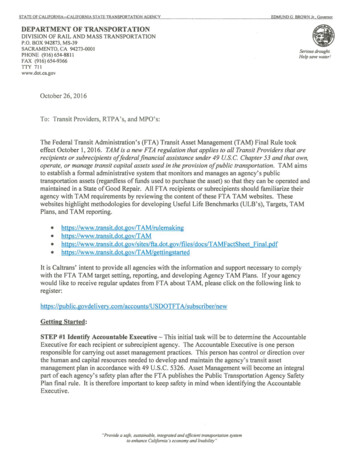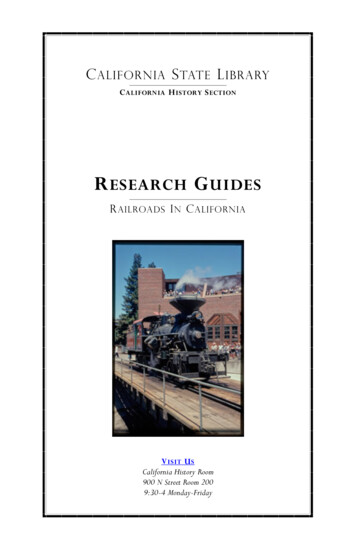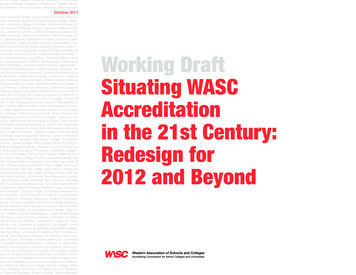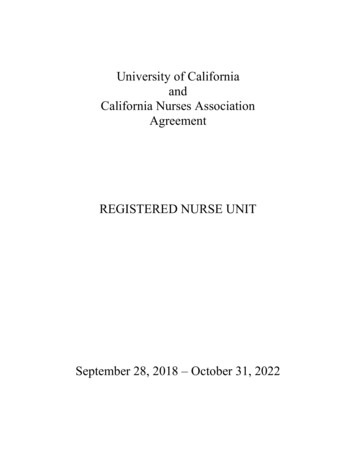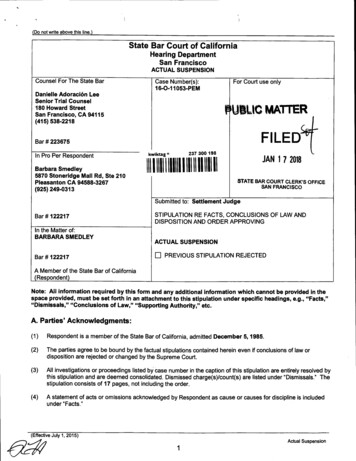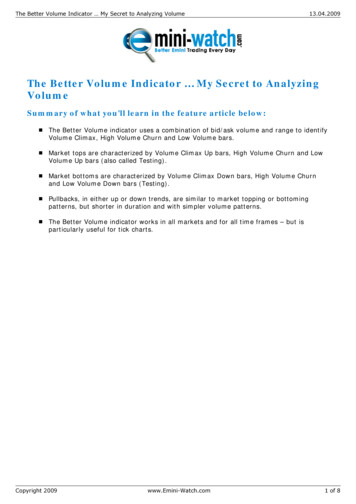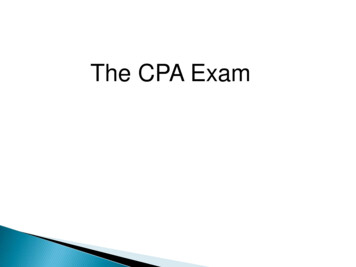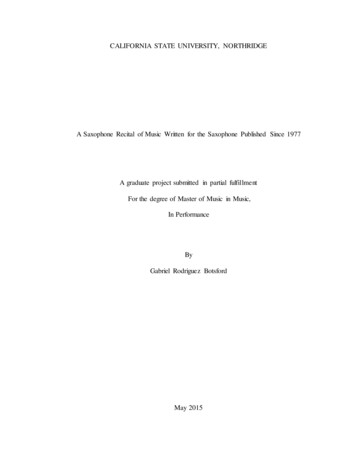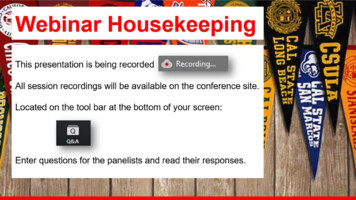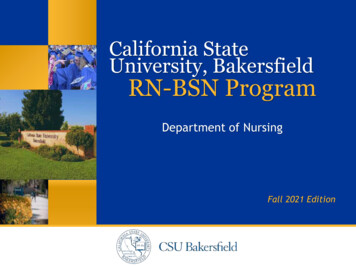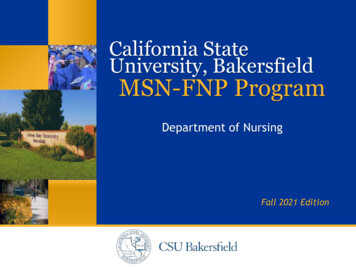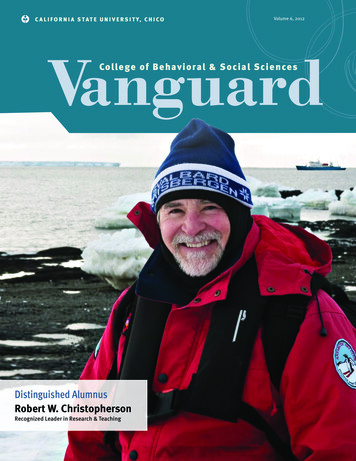
Transcription
C a l i f o r n i a S t at e U n i v e r s i t y, c h i c oVolume 6, 2012VanguardCollege of Be ha vi o ral & S o cial S ci e n cesDistinguished AlumnusRobert W. ChristophersonRecognized Leader in Research & Teaching
California State University, Chico is the second-oldest campus among the 23that comprise the California State University System. This year marks our125th anniversary. The campus was founded in 1887 with the approval ofa state legislative act permitting the development of a “Normal School” inNorthern California. General John Bidwell generously donated eight acres ofhis cherry orchard toward the building of the school. The cornerstone to the“Normal School” was laid in 1888; the doors opened in September of 1889, and the first classgraduated two years later with 15 students. Over the years the school’s name changed fromChico Normal School (1887) to Chico State Teachers College (1921) to Chico State College(1935), and to California State University, Chico (1972). For 125 years, CSU, Chico hassustained a strong tradition of academic excellence and has remained committed to studentlearning and student success.Much has changed since 1887, but our mission to provide high-quality education to studentsand serve the region remains steadfast. Faculty and staff in the College of Behavioral andSocial Sciences effectively provide students with outstanding interactive and leading-edgelearning opportunities that ignite their curiosity about the world, develop their criticalthinking skills, prepare them as engaged citizens and workers, and encourage them to cravelife-long learning.DEAN’SMany of our graduates make significant contributions to society, and when possible weMESSAGEas our outstanding Behavioral and Social Sciences Distinguished Alumnus. For moreacknowledge their outstanding contributions. This year we honor Mr. Robert Christophersoninformation about his impressive professional achievements, please read the cover story onpages 6 and 7.Professor Christopherson, and all of our students in BSS, are not only inspired by thesubjects they study, but also by the talented faculty who teach them. Faculty achievementsin this college are many. As featured in this issue of Vanguard, I wish to congratulate Drs.Way (Political Science) and Oppy (Psychology), who have earned prestigious fellowships withthe American Council on Education.We are proud of our students, faculty, staff, and alumni and the contributions they makein the world. They are “you.” So please, when you have a moment, share with us yourachievements and contributions by e-mailing me at the address that appears below.On behalf of the college, we look forward to hearing from you and wish you and yours ahappy and healthy summer ahead.Gayle E. Hutchinson, Deanghutchinson@csuchico.edu
C O N T E N T S2Social Science2Social Work3Anthropology4Multicultural & Gender Studies4Sociology5Psychology6–8 Geography & Planning8Economics9Political Science10Health & Community Services11Child Development12Faculty Accomplishments13College Events
s o c i a l sc i enceGPS Guides Chico State to Local Elementary SchoolsSix years ago, a parent at Chico Country DaySchool inquired if someone in the SocialScience Program (SOSC) would be willingto teach Global Positioning Systems (GPS)technology to his child’s fourth grade class.Steve Stewart, a SOSC instructor, respondedSOCS 301 is a required course for LiberalStudies majors and for some Social Sciencemajors planning on entering a credentialprogram and is proving to be a win-win-win foreveryone involved. The participating collegestudents often ask if they can do more of theseto the request, and it was so successful that itis now included in the syllabus for his SpatialConcepts class (SOSC 301) and encompassestypes of activities; the fourth graders likelooking for “treasures” and using maps, andthe teachers are uniform in their praise thatworking with fourth graders from variouselementary schools in the Chico UnifiedSchool District.SOSC 301 students have provided a wonderfullearning experience for their classes.Due to the success of the GPS service learningproject, SOSC 301 students have expandedtheir activities to cover other spatial concepts,such as latitude and longitude, map reading,landforms, and climate.SOCIAL WORKGraduate Social Work Students in Action:Senior Legislative DaysThe California Senior Legislature (CSL) was established in 1980 forthe purpose of providing model legislation for older citizens andadvocating for the needs of seniors. The objectives include identifyingpriority senior concerns, developing legislative proposals in response tothose concerns, and advocating for the inclusions of these in the StateLegislative process. Each October the CSL hosts Senior LegislativeDays. Seven students from CSU, Chico’s School of Social Workattended the event this past October and learned a great deal aboutthe legislative process as well as a variety of issues that are impactingseniors in the state. The state-sponsored senior legislature providesstudents with an experiential learning opportunity that promotesintergenerational mentoring and political advocacy. Participation inthe event is an opportunity for students to participate in a uniqueintergenerational co-learning experience.2Department of Social Work students and faculty attend Senior Legislative Days.
A n t h r o p o lo gyThe Ishi CentennialOn August 29, 1911, Ishi, the last living member of a small band of Yahi Indians,chose to walk into the Euro-American society of the early 20th Century. TheDepartment of Anthropology coordinated several events to celebrate this importantcentennial and enhance our relationship with neighboring Native Americancommunities. We began with a symposium dedicated to Ishi at the Society forAmerican Archaeology in Sacramento. Faculty and students from the departmentaddressed several issues regarding the material culture, physical characteristics,and the ethnic identity of Ishi. Many of these same speakers participated in the Ishispeaker series as part of the Anthropology Forum, a community venue. In October2011, California State University, Chico hosted the 26th Annual California IndianConference, and in December, the Valene L. Smith Museum of Anthropology openedan exhibition on Ishi.Coming HomeIshi’sLongJourneyDec 13, 2011–July 26, 2012The Celebration Continues!FREE ADMISSIONTUESDAY–SATURDAY11:00 A.M.– 3:00 P.M.SUMMER HOURS BEGIN: JUNE 4, 2012MONDAY–THURSDAY 11:00 A.M.– 3:00 P.M.One of the outcomes of this productive year has been a series of films producedin our Advanced Visual Anthropology Lab (ALVA). One of these films, CaliforniaIndian Voices, premiered on February 23, 2012 and drew a capacity crowd to theAnthropology Forum. At least 20 representatives of regional Native American tribesattended, and we anticipate many future opportunities for continued collaboration.Researched, designed, and installed bystudents and Professor Stacy Schaefer inANTH 467, Exhibit Installation.Valene L. Smith Museum of AnthropologyIn the Meriam Library complex next to the Turner Museum (530) 898-5397California State University, ChicoPhotos Courtesy of the Phoebe A. Hearst Museum of Anthropologyand the Regents of the University of California. Photography byAlfred L. Kroeber, Catalogue No. 15-5728, 15-1347, 15-5404, 15-5414.The California Indian ConferenceSeven hundred people came from around California to participatein “Sustaining the Circle of Knowledge,” the 26th Annual CaliforniaIndian Conference. From the opening blessing to the closingceremonies, it was a time of rich learning, sharing, and connectingwith others. Amy Huberland, assistant coordinator of the NortheastHistorical Resources Information Center and coordinator of theconference, attributed the great success of the conference to thecombined efforts of local tribes, CSU, Chico, faculty, staff, andstudents, state and federal agency representatives, and communitymembers. An unprecedented number of attendees participated inpresentations, workshops, tribal-hosted meals, traditional Nativeperformances, a Youth Track, a contemporary Native American artshow, and a master basket weavers demonstration. The event offeredan exceptional opportunity for tribal members from across the stateto network with academics, students, agency representatives, andcommunity members and in addition, highlighted the beauty of CSU,Chico and the North State.The Valene L. Smith Museumof AnthropologyThe current exhibit, Coming Home: Ishi’s Long Journey, traces hismany encounters, transformations, and adaptations to the modernworld. From the beginning of his journey with a short stay in theOroville jail to entering Victorian society in San Francisco, Ishibecame a part of a new chapter in Native American history. WithProfessor Alfred Kroeber in the anthropology department of theUniversity of California, Berkeley, Ishi provided a first-hand andpersonal account into a bygone way of life. His stories and his workwith the anthropologists have left a profound history of insight,information, and material culture that help better explain thecultural practices of the Yahi people and of California Indians, ingeneral. The exhibit will run through July 26, 2012.3
M u lt i c u lt u ra l & G ender S t u d i esInterns Put Activism into PracticeStudents at the Center for Multicultural and Gender Studies (MCGS)benefit from service learning in the form of internships, in which theydraw on the theoretical background they have been exposed to in theclassroom and apply it in their work with real-world organizations.Molly Heck, who earned her undergraduate degree from MCGS and wenton to earn a Masters of Social Work in the College of Behavioral andSocial Sciences at CSU, Chico, supervises these interns each semester.“Both the general major in Multicultural and Gender Studies andthe Women’s Studies major as well as all eight minors (MulticulturalStudies, Women’s Studies, African American Studies, Asian AmericanStudies, American Indian Studies, Chicano Studies, Managing Diversity,and Sexual Diversity Studies) can take internship units that counttoward the degree,” Heck said.Chico State students march in the “Take Back the Night” event held in November.Heck recently gave a presentation on how MCGS majors study contentarea and then apply it to become activists in different areas. “My studentscome alive when they realize what they learn in class is used in the tasksthey take on,” Heck said.Activism is nothing new to the Center for Multicultural and GenderStudies, which dates back to the 60’s when students demanded AfricanAmerican studies be made available to Chico State students. Currently,most of the non-dominant groups on campus are reflected in the areasof student in the center. “The legacy of diversity, multiculturalism,inclusion and pluralism is alive and well here at the Center!” said KurtNordstrom, director of MCGS.S O C IOLO G YSociology Professor to be Featured on NationalGeographic Television ShowSociology professor Liahna E. Gordon willappear on an upcoming episode of TheNational Geographic Channel’s series Taboo.The series seeks to take viewers into worldspreviously unknown to explore behaviorsand lifestyles that many people find odd,confusing, or even revolting. Gordon, whosearea of specialization is the sociology ofsexuality, was asked to appear as an expert onthe show. This particular episode focused onpeople with fetishes, and she was asked not4only to explain from a sociological perspectivewhy people have fetishes, but also the socialrepercussions they are likely to suffer forbreaking our culture’s sexual norms. Sincesexual deviance is most often explained inthe media from a perspective of pathology,Ptofessor Gordon was particularly delightedthat the show’s producer specifically sought toadd a sociological viewpoint to the issue. Theepisode is expected to air next fall.Dr. Liahna E. Gordon
Ps y c h o l o g yFrom left to right: Lucia Pineda, Kate Corey, Jennifer Olsen, Lauren Heusser, Melissa I. Virrueta, Cori Brown, Elizabeth Edgington (back), Debbie Wood, Skip Hauenstein.School Psychology at Chico State:Making a Difference in the Lives of Children and AdolescentsAs life becomes more challenging for ouryouth, schools and communities are undercontinuous and mounting pressure to provideinstructional assistance and mental healthservices to support the needs of children andadolescents. The educational systems todayserve increasingly diverse student populations,and each child brings unique strengths anddifficulties to the learning process. Therefore,school psychologists can play a crucial role inthe collective efforts to discover and unlockeach child’s potential for success.The Pupil Personnel Services (PPS) Programat CSU, Chico is a three-year, state- andnationally-accredited school psychologyprogram that includes an internship in thepublic schools. Our program philosophy haslong emphasized proactive, comprehensive,and prevention-oriented services andintervention at a systemic level, wherepossible. Our graduate students are trainedin a wide range of pupil personnel functionsincluding, but not limited to, behavioraland instructional consultation, cognitiveand behavioral assessment, counselingand crisis intervention, inservice training,program development and evaluation,and collaboration with other professionalsand community agencies. Throughoutthe program, students take courseworkwhile gaining practical experience inschool placements throughout the region.They finish the program with an M.A. inPsychology (Option in Applied Psychology)and a PPS Credential in School Psychology.In addition, since it became a programrequirement in 2007, 100 percent of ourgraduates have taken and passed the NationalSchool Psychology Exam, which in turnmakes them eligible to become NationallyCertified School Psychologists (NCSP).School psychologists positively impactchildren’s lives and make a lasting differencein communities across the nation. Thedemand for school psychologists is evidentand on the rise. In these unpredictablefinancial times, the field of school psychologyhas proven to be a stable career choice withrobust growth opportunities and has, in fact,been cited by US News and World Report as atop profession since 2002. Our PPS graduatesfrom Chico State have had tremendoussuccess in securing immediate and lucrativeemployment after graduation and arefrequently sought after by school districtsthroughout the state. Recent graduateCarrie Suchy, now a school psychologist inWashington, secured a position even prior tograduation and believes that her training atChico State enabled her to be a competitiveout-of-state candidate.5
G e o gra p h y & P l ann i ngDISTINGUISHEDALUMNUS:Robert W. ChristophersonA Recognized Leader in Research and TeachingOnce a year, the College of Behavioral and Social Sciences has theopportunity to recognize an outstanding alumna/us who has truly hada positive and profound impact on society. This year, the college isproud to recognize Mr. Robert W. Christopherson.Christopherson received his Bachelor of Arts degrees in bothgeography and history from California State University, Chicoin 1969, and his MA in Geography from Miami University, Ohio.Christopherson’s first textbook was published in 1992; he is now theauthor of the leading physical geography texts in the U.S. and Canada:Geosystems, 7/e; Elemental Geosystems, 6/e; Geosystems CanadianEdition, 2/e; and Applied Physical Geography, 7/e, all published byPearson Prentice Hall. His wife, Bobbé, serves as photographer andproduction assistant on his textbooks, which have received numerousnational awards.Christopherson working on a textbook update inhis home office.6According to Christopherson, the steering of academics in appliedand relevant directions, given the rate of global change, is at a criticaljuncture. He believes geospatial science is the essential discipline to
G e o gra p h y and P l ann i ngRobert Christopherson is the author of the best-sellingphysical geography texts in the US and Canada:GeosystemsAN INTRODUCTION TO PHYSICAL GEOGRAPHYEIGHTH EDITIONRobert W. Christophersoninteraction of the atmosphere, hydrosphere, andlithosphere, all powered by solar energy. This is theROBERT CHRISTOPHERSONscope of physical geography as organized for studentsMARY-LOUISE BYRNEPHILIP GILESTHIRD CANADIAN EDITIONin the four-part structure of Geosystems.Our planet and our lives are powered by radiant energy from the Sun. Earth’satmosphere acts as an efficient filter. The unevenness of daily energy receiptempowers atmospheric and surface energy budgets, giving rise to globalpatterns of temperature and circulation of wind and ocean currents. Winter scene in northeastern Arizona desert.PART II (CHAPTERS 7–10): THE WATER, WEATHER, AND CLIMATE SYSTEMSPART III (CHAPTERS 11–17): THE EARTH-ATMOSPHERE INTERFACEEarth is a dynamic planet whose surface is shaped by two broad systems.The endogenic system encompasses internal processes that produce flows ofheat and material from deep below Earth’s crust. Earth’s surface responds bymoving, warping, and breaking, sometimes in dramatic episodes. At the sametime, the exogenic system involves external processes involving air, water, andice, all powered by solar energy. Buttes, mesas, sand dunes in the desert along the Utah–Arizona border.PART IV (CHAPTERS 18–21): SOILS, ECOSYSTEMS, AND BIOMES[Earth photo courtesy of NASA. All other photos by Bobbé Christopherson]Geosystems is supported by MasteringGeography assignable activitiesthat include geoscience animations, Encounter Geosystems Google Earth multimedia, Thinking Spatially figure labeling, MapMaster interactive maps,geography videos, test bank questions, reading quizzes, and .comFPOISBN-13: 978-0-321-70622-5ISBN-10:0-321-70622-69780321 706225eighth editionEarth is the home of the only known biosphere, a unique, complex, andinteractive system of abiotic (nonliving) and biotic (living) components workingto sustain a tremendous diversity of life. Today we face crucial issues, principallythe preservation of the diversity of life. The resilience of the biosphere, as weknow it, is being tested in a real-time, one-time experiment, as global climatesystems shift. Fur seals on tussock grass, South Georgia Island, Antarctica.E D I T I O NGeosystemsEarth is the water planet. We see the daily dynamics of the atmosphere—thepowerful interaction of moisture and energy, of stability and instability, andthe variety of cloud forms—as daily weather patterns, the hydrologic cycle,water resources, and climate. Scenes of an ice-free Arctic Ocean remind us ofthe importance of climate change science in physical geography. Cumulonimbus clouds, downpour, at sunset.E I G H T HCHRISTOPHERSONPART I (CHAPTERS 2–6): THE ENERGY-ATMOSPHERE SYSTEMPlanet Earthphotographedfrom approximately37,000 km (23,000 mi),December 1972.GEOSYSTEMSThe diversity in the biosphere is a response to the9 0 0 0 0CHRISTOPHERSONChauveau Glacier where it calves into Ayer Fjord, accessible only by hiking onto large morainal deposits after a Zodiacride. About 10 years ago, this glacier filled the entire fjord. Climate change is impacting the polar regions at twice therate of the middle and lower latitudes. Photos by Bobbé Christopherson.understand the complex interrelationships and linkages between Earthsystems and human systems. His future vision for higher education isa move from descriptive compartments to relational perspectives, keyelements of spatial analysis and systems methodologies.Christopherson, in reminiscing about his student days at Chico State,said, “My time at CSU, Chico was so important in shaping my trackto graduate school at Miami University (Ohio) and then onto myprofessorship. Bruce Bechtol and Margaret Trussell were key mentorsto me in the department, as well as Art Karinen, David Lantis, LaddJohnson, and Bill Hutchinson, fondly known as Old Hutch. In fact,Old Hut
community members and in addition, highlighted the beauty of CSU, Chico and the North State. The Valene L. Smith Museum of Anthropology The California Indian Conference The Celebration Continues! Dec 13, 2011–July 26, 2012 Journey Long Ishi’s Coming Home In the Meriam
